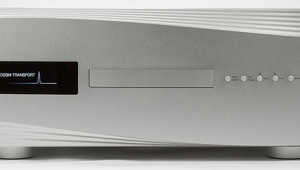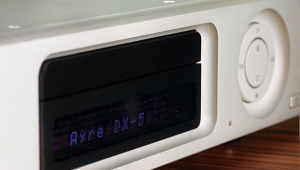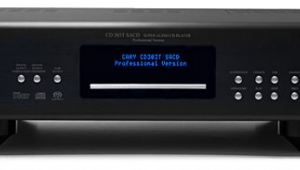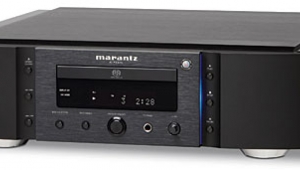| Columns Retired Columns & Blogs |
dCS Verdi La Scala CD/SACD transport & Delius D/A converter
Giuseppe Verdi gave the world more than two dozen operas, some good sacred music, and one string quartet. He also provided the young Arturo Toscanini with one of his first big breaks—conducting the singing of "Va pensiero" at his burial procession—and gave the flagship consumer product from England's dCS Ltd. its name. That the latter two gestures were posthumous and unwitting does nothing to diminish their poetry.

The dCS Verdi is a grandly expensive ($14,995) CD/SACD transport, introduced in 2001 and intended for use in the world's finest domestic replay systems. (dCS also designs and manufactures digital audio equipment for the pro market.) The brand-new Verdi La Scala, the surname of which honors the opera house that gave witness to the premieres of so many of Giuseppe Verdi's masterpieces, is an even grander version of the dCS transport, and one that contains a key refinement: The Verdi La Scala is an upsampling transport. File that away for later.
I reviewed the Verdi La Scala in tandem with dCS's own Delius digital-to-analog converter, partly because the transport can't make music without a DAC of some or another sort, and partly because the Delius, which was introduced in 1999, has yet to be discussed in these pages. I did not use the dCS Purcell consumer upsampler as a part of the review system (see Stereophile, April 2003) because a Verdi La Scala is a dCS Verdi plus a dCS Purcell, wrapped up in the same box (but see below). And I did not use the dCS Verona master clock as part of the review system, because John Atkinson is reviewing that himself [in the March issue], and he's the boss.
Confused yet? Hold on to your hats.
Ring first
The Verdi La Scala is built into a double-stack version of the standard dCS chassis: a foursquare but finely made thing that uses a clever arrangement of rubber ridges instead of feet, making the various dCS products easy to stack and seeming to provide very good resistance to external vibrations. The CD mechanism is a Sony twin-laser drive, and the supporting electronics are contained on three substantial boards below the transport proper, alongside a digital (switching) power supply. The serenely pretty front panel contains all the controls you'd expect on a transport, plus a few you might not, for scrolling through and selecting different software choices. There's also a bidirectional knob, useful for all the above.
Crack open a Delius and you'll see another digital power supply, six especially chunky electrolytic caps, some nice-looking crystal oscillators (for the clock, I'll bet), a 32-pin PROM socket, and a whole lot of chips. Some of the parts and PCB traces are so tiny and crammed so close together that it hurts to look at them. Fair enough: If I were to assemble something like this, I'd charge several thousand dollars for labor alone.
But what do all those pieces do? And do you really need them all—knowing that we live in an age when you can buy a pink portable Hello Kitty CD player that runs on batteries and does ostensibly the same thing? I'll try to answer that, God help me. But let's pause first and:
Consider that, in the pre-DSD world of D/A converters, consumers had a choice between two different schemes: multibit and single-bit, the former preceding the latter as a consumer reality by a few years, but the latter actually preceding the former as a theory for a great many more years.
Multibit PCM, the technology at the heart of those first run-right-out CD players of 1983, was capable of reproducing sound with a certain degree of success. But as chip technology improved in the ensuing years, the idea of single-bit conversion once again appealed to some engineers, owing to its greater simplicity and ease of implementation. (A 16-bit system calls for 65,536 possible electrical values to be available in constructing the music waveform, which is devilishly difficult to engineer with real accuracy.) But even in the best implementations, a problem remained in that single-bit digital is more prone to quantization noise, thus putting the emphasis back on the need for more and more clever filtering techniques. Low-level nonlinearities or quantization noise: Will it be the tiger or...the other tiger?
In the early 1990s, dCS introduced a sort of a compromise between the two technologies: a completely original D/A design called the Ring DAC, a five-bit, 64x-oversampling system implemented using FPGAs and standard logic. (These days it can be done on a single chip, à la Philips or Burr-Brown.) The Ring DAC's designers believed theirs was a more linear approach to re-creating an analog waveform than single-bit or multi-bit, and in its first consumer implementation—the successful dCS Elgar DAC, now in v.4.22 Elgar Plus guise—the process was claimed to offer the first true 24-bit performance on the consumer market. And while this may be an oversimplification, one can see in the first Ring DAC at least some hint of Direct Stream Digital, with its single-bit processing and very high sampling rate.
But the Ring DAC is no longer the only peg on which dCS hangs its hat, the company having now brought upsampling to the masses. As contrasted with an oversampling filter, which processes the datastream at a higher frequency in order to shift the spectrum of quantization noise up and away from the range in which it is most influential (and not in an effort to feign greater information density), upsampling is a process in which the sampling rate is increased prior to conversion in order to eliminate the need for steep-slope analog filtering altogether—allowing the designer to do all of those things benignly, in the digital domain.
And while it may seem easy to explain, upsampling is a great deal harder to justify, at least in technical terms: Plainly put, there's no reason to expect a digital audio system to sound better just by putting, say, a 44.1kHz recording through a 176.4Hz DAC without actually increasing the amount of information. Yet, while acknowledging this apparent contradiction, dCS suggests that upsampling works nonetheless. And consumer reaction, not to mention reviewer reaction, to the first consumer upsampler, the dCS Purcell (1999), seems to have borne them out.
- Log in or register to post comments




































